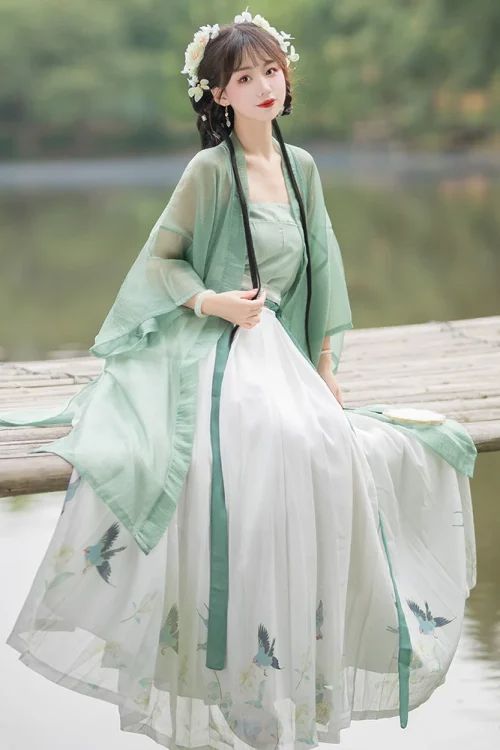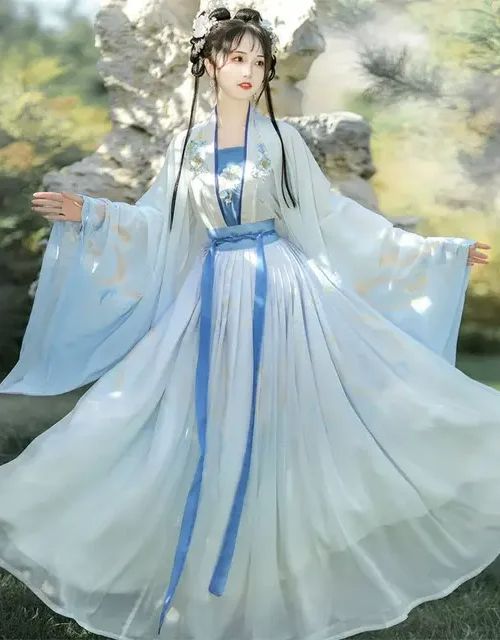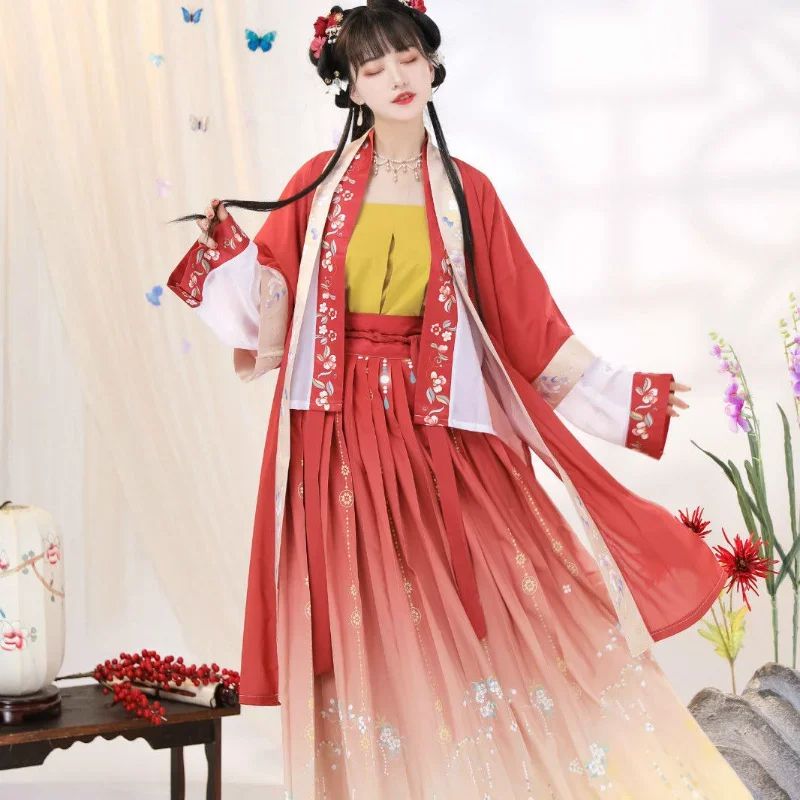The Significance of Hanfu in Song Dynasty Society
In the tapestry of Chinese history, the Song Dynasty stands out as an era of cultural refinement and artistic brilliance. Among the many cultural practices that flourished during this period, the wearing of Hanfu, the traditional Chinese clothing, held profound significance.

Hanfu as an Embodiment of Identity
Hanfu was not merely a garment; it was an embodiment of cultural identity and social status. The intricate designs, vibrant colors, and flowing fabrics reflected the Song Dynasty’s aesthetic sensibilities and its reverence for tradition. The wearing of Hanfu was not confined to the elite; it permeated all levels of society, from the imperial court to the common people.
Symbol of Authority for the Ruling Class
For the ruling class, Hanfu served as a symbol of authority and power. The emperor and his court wore elaborate robes adorned with dragons, phoenixes, and other auspicious motifs. These garments were not only visually stunning but also imbued with symbolic meaning, representing the emperor’s divine mandate to rule.
Expression of Refined Tastes for the Literati
For the literati, Hanfu was an expression of their refined tastes and scholarly pursuits. They favored simple and elegant robes made from fine fabrics such as silk and cotton. The literati often wore their Hanfu while engaging in literary activities, such as poetry composition and calligraphy.
Practical Versatility for Common People
For the common people, Hanfu was a practical and versatile garment. It was worn for everyday activities, such as farming, trading, and socializing. While the designs and materials of commoners’ Hanfu were less elaborate than those of the elite, they still reflected the cultural values and traditions of the Song Dynasty.
Role in Ceremonies and Rituals
Beyond its practical and symbolic significance, Hanfu also played a crucial role in various ceremonies and rituals. During weddings, the bride and groom would wear traditional Hanfu to symbolize their union and the continuation of their family lineage. Funerals were also occasions for the wearing of Hanfu, as it was believed to honor the deceased and guide their spirits to the afterlife.
A Unifying Force in Society
The importance of Hanfu in Song Dynasty society cannot be overstated. It was a tangible manifestation of cultural identity, social status, and religious beliefs. The wearing of Hanfu fostered a sense of unity and belonging among the people of the Song Dynasty, and it continues to be a source of pride and inspiration for Chinese people today.
汉服: A Symbol of Cultural Identity and Tradition
In the tapestry of Song Dynasty society, cultural practices and ceremonies held immense significance, and among them, the donning of Hanfu, the traditional Chinese attire, played a pivotal role. Hanfu was not merely a garment; it was an embodiment of cultural identity, a symbol of tradition, and a testament to the refined aesthetics of the era.

Worn by All Walks of Life
During the Song Dynasty, Hanfu was worn by people from all walks of life, from the imperial court to the common folk. The intricate designs, vibrant colors, and flowing fabrics of Hanfu reflected the artistic sensibilities of the time. The upper classes often adorned themselves in elaborate Hanfu made from luxurious materials such as silk and brocade, while the lower classes wore simpler garments made from cotton or hemp.
A Social Marker
Beyond its aesthetic appeal, Hanfu also served as a social marker. The style, color, and accessories of one’s Hanfu indicated their social status and occupation. For example, officials wore formal Hanfu with specific insignia, while scholars favored more subdued colors and simpler designs. This sartorial code helped maintain social order and facilitated easy identification of individuals within the complex hierarchy of Song society.
Role in Ceremonies and Rituals
Furthermore, Hanfu played a crucial role in various ceremonies and rituals. During weddings, the bride and groom would wear traditional Hanfu to symbolize their union and the continuation of family lineage. Similarly, during funerals, mourners would wear white Hanfu as a sign of respect for the deceased. These ceremonies were not only occasions for social gatherings but also opportunities to showcase the beauty and significance of Hanfu.
Influence of Confucianism
The Song Dynasty witnessed a flourishing of Confucianism, which emphasized the importance of tradition and social harmony. Hanfu, as a symbol of cultural continuity, was highly valued by Confucian scholars and officials. They believed that wearing Hanfu helped preserve the customs and values of their ancestors. This reverence for Hanfu contributed to its widespread adoption and popularity throughout the dynasty.
结论
In conclusion, Hanfu was an integral part of Song Dynasty society, serving as a symbol of cultural identity, a social marker, and a ceremonial garment. Its intricate designs, vibrant colors, and flowing fabrics reflected the artistic sensibilities of the era, while its social significance reinforced the importance of tradition and social harmony. Through Hanfu, the people of the Song Dynasty expressed their cultural heritage and celebrated the beauty and richness of their civilization.
The Role of Hanfu in Preserving Chinese Heritage
In the tapestry of Chinese history, the Song Dynasty stands out as an era of cultural refinement and artistic brilliance. Amidst this vibrant cultural landscape, Hanfu, the traditional Chinese attire, played a pivotal role in preserving the nation’s heritage and shaping its social fabric.

A Symbol of Identity and Status
Hanfu, with its intricate designs and flowing silhouettes, was more than just clothing; it was a symbol of cultural identity and social status. During the Song Dynasty, Hanfu reached its zenith, becoming an integral part of daily life and ceremonial occasions.
Testimony to Wealth and Refinement
For the elite, Hanfu was a testament to their wealth and refinement. Elaborate robes adorned with intricate embroidery and precious stones were reserved for formal gatherings and court functions. The common people, too, wore Hanfu, albeit in simpler forms. However, regardless of social status, Hanfu served as a unifying force, connecting people across different walks of life.
Deep Cultural Significance
Beyond its aesthetic appeal, Hanfu also held deep cultural significance. It was believed to embody the Confucian values of propriety and respect. The proper wearing of Hanfu was seen as a reflection of one’s moral character and social standing.
Connecting to the Past
Moreover, Hanfu played a crucial role in preserving Chinese heritage. It served as a tangible link to the past, connecting the Song Dynasty to its ancient roots. Through its intricate designs and symbolism, Hanfu conveyed stories and legends, passing down cultural traditions from generation to generation.
Ceremonies and Rituals
The Song Dynasty witnessed a flourishing of Hanfu-related ceremonies and rituals. The most notable of these was the “Jijie” ceremony, held annually to celebrate the emperor’s birthday. During this grand occasion, the emperor and his court would don their finest Hanfu, symbolizing the unity and prosperity of the nation.
结论
The importance of Hanfu in Song Dynasty society cannot be overstated. It was not merely a garment but a symbol of cultural identity, social status, and historical continuity. Through its intricate designs, flowing silhouettes, and deep cultural significance, Hanfu played a vital role in preserving Chinese heritage and shaping the social fabric of the era.
